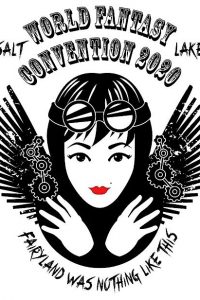Nalo Hopkinson: As Magic Does
 Nalo Hopkinson was born December 20, 1960 in Kingston, Jamaica, and grew up there and in Trinidad and Guyana, though she also spent some time in the US as a child. Her father was noted Guyanese poet Muhammad Abdur-Rahman Slade Hopkinson. She moved with her family to Toronto, Canada in 1977, where she lived until relocating to Riverside CA in 2011. She earned a Master’s degree in Writing Popular Fiction from Seton Hill University, where James Morrow was her mentor. She is now a professor in the Creative Writing Department at the University of California Riverside. She has taught at Clarion, Clarion West, and Clarion South, and helped found the Carl Brandon Society, which exists to further the conversation on race and ethnicity in science fiction and fantasy. She won the John W. Campbell Memorial Award for Best New Writer in 1998.
Nalo Hopkinson was born December 20, 1960 in Kingston, Jamaica, and grew up there and in Trinidad and Guyana, though she also spent some time in the US as a child. Her father was noted Guyanese poet Muhammad Abdur-Rahman Slade Hopkinson. She moved with her family to Toronto, Canada in 1977, where she lived until relocating to Riverside CA in 2011. She earned a Master’s degree in Writing Popular Fiction from Seton Hill University, where James Morrow was her mentor. She is now a professor in the Creative Writing Department at the University of California Riverside. She has taught at Clarion, Clarion West, and Clarion South, and helped found the Carl Brandon Society, which exists to further the conversation on race and ethnicity in science fiction and fantasy. She won the John W. Campbell Memorial Award for Best New Writer in 1998.
Hopkinson’s first professional SF sale was ‘‘A Habit of Waste’’ (1996), in the Canadian feminist journal Fireweed. Notable stories include ‘‘Riding the Red’’ (1997), which she wrote at the Clarion writing workshop in 1995, Tiptree finalist ‘‘The Glass Bottle Trick’’ (2000), World Fantasy Award nominee ‘‘Something to Hitch Meat To’’ (2001), and Aurora finalist ‘‘The Smile on the Face’’ (2004). Some of her short fiction has been collected in World Fantasy Award and Sunburst Award winner Skin Folk (2001) and in Report from Planet Midnight (2013).
Debut novel Brown Girl in the Ring (1998) won the Warner Aspect First Novel Contest, the Locus Award for best first novel, and was a finalist for the Dick, Tiptree, Crawford, and Aurora Awards. Midnight Robber (2000) was a finalist for the Hugo, Tiptree, Dick, Sunburst, and Nebula Awards. The Salt Roads (2003) was a Nebula Award finalist and won a Gaylactic Spectrum Award. The New Moon’s Arms (2007) won Aurora and Sunburst awards and was a finalist for Nebula, Campbell, and Mythopoeic awards. Her first YA novel, The Chaos, appeared in 2012, and her latest novel for adults, Sister Mine, earlier this year.
Hopkinson edited anthologies Whispers from the Cotton Tree Root: Caribbean Fabulist Fiction (2000), a World Fantasy Award nominee; Mojo: Conjure Stories (2003); Aurora Award finalist So Long Been Dreaming: Postcolonial Science Fiction and Fantasy (2004, with Uppinder Mehan); and Aurora Award winner Tesseracts Nine: New Canadian Speculative Fiction (2005, with Geoff Ryman). She curated ‘‘radio fiction anthology’’ Six Impossible Things for CBC radio (2006, with Joe Mahoney).
Excerpts from the interview:
 ‘‘I spent five years mostly too sick to write, pretty much too sick to do anything, destitute, and for two of those years homeless and struggling. I had anemia, and no oxygen to the brain makes it really hard to read from one end of a sentence to the other. I could not read. I could not write. But every so often I’ll go through an old notebook or find a file I don’t recognize and I open it up, and there’s a page or two of writing that I did during that time that I do not remember. At some level I was still writing. The cool part about it is, the writing is pretty good!*
‘‘I spent five years mostly too sick to write, pretty much too sick to do anything, destitute, and for two of those years homeless and struggling. I had anemia, and no oxygen to the brain makes it really hard to read from one end of a sentence to the other. I could not read. I could not write. But every so often I’ll go through an old notebook or find a file I don’t recognize and I open it up, and there’s a page or two of writing that I did during that time that I do not remember. At some level I was still writing. The cool part about it is, the writing is pretty good!*‘‘Just before everything went pear-shaped with my health, my agent made a three-book deal for me. I managed to submit the first book in that deal, The New Moon’s Arms. Writing it was hard, because at that point I didn’t realize I was descending into this deep anemia. Writing that thing was brutal. I noticed when it came out that there were lots of repetitions in it, because my attention span was down to about a minute or two at that point. Despite what some people think, I know exactly how the magic works in the book. I thought it out very carefully. But I was telling the story through the eyes of somebody who is only half aware of the magic, who has lived with some version of that magic all her life anyway, and so doesn’t find it all that weird. She has her own shit going on, and magic happens, as magic does. Two years ago my agent was doing a writing workshop and he asked me to come and speak to the students, specifically about The New Moon’s Arms. Their reactions to the book were divided right down the middle. Some of them were genre writers and some of them weren’t. One of the genre writers said, ‘The cool thing about this book is that it’s got mermaids. But it’s frustrating because you don’t really talk about that.’ They asked me why I didn’t do it differently, and I said, ‘It just wasn’t how that book wanted to be written.’ It wasn’t, ‘Here’s my story about mermaids, and here’s how that works.’ It’s my story about a middle-aged woman trying to deal with the changes in her life. The other half of the audience was used to reading more mimetic fiction, and they found it quite charming, but did not always pick up that there were mermaids. The ways people read things just amaze and humble me, and teach me all sorts of things about how fiction works.”
…
 ‘‘The Chaos was my first young-adult novel, and it’s kind of hinky. Some things work, and some things don’t quite work. What I found, to my surprise, was that I didn’t anticipate how many young adults would find it too unsettling, and decide that was my fault – that I had done it by accident, or something. When I was that age, I would have just taken it page by page, and then gotten to the end and gone, ‘Huh’. OK, so they’re not going to explain anything – I’m just going to have to take the book as is.’ Which is what I did with The Metamorphosis by Kafka. People have also said that they’ve found Scotch unlikeable. I have to go with that, because if they did, they did. I’m not sure what they found unlikeable. I continue to learn.”
‘‘The Chaos was my first young-adult novel, and it’s kind of hinky. Some things work, and some things don’t quite work. What I found, to my surprise, was that I didn’t anticipate how many young adults would find it too unsettling, and decide that was my fault – that I had done it by accident, or something. When I was that age, I would have just taken it page by page, and then gotten to the end and gone, ‘Huh’. OK, so they’re not going to explain anything – I’m just going to have to take the book as is.’ Which is what I did with The Metamorphosis by Kafka. People have also said that they’ve found Scotch unlikeable. I have to go with that, because if they did, they did. I’m not sure what they found unlikeable. I continue to learn.”
…
‘‘I’m not working on Blackhart Man at the moment because I’m teaching. But I will be in San Francisco for a month over the summer, and that’s when I can hopefully work some more it. I cannot write quickly on command any more, so God knows when I’ll be done. But I’m hoping. It’s a good book. I really would like to finish it and shop it around. I’m also shopping around a short story collection. There’s this comic I’ve been thinking about for years, and I’ve finally got a handle on it. So I’m really excited about it, but of course I’ve never written a comic book script before, even though I’ve studied how to do so. You really have to pick which words you use – you can’t just ramble on. I have two titles in mind. At this point I think it might be called Nancy Jack. Which is going to confuse people because it’s about a guy. In a way. ‘Nancy’ is short for ‘Anansi,’ the trickster creature from Afro-Caribbean folklore. I think confusion is really the way to go. It has so many more interesting possibilities.’’





